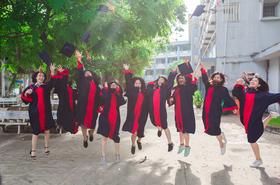- Rhodes State College is a public, state-assisted institution of higher learning which is chartered to provide degree granting career education programs, non-credit workforce development, and consulting for business and industry. The College prepares students for entry into careers, develops the regional workforce through credit and non-credit occupational training, and offers curricular programs that prepare students for transfer completion baccalaureate programs at selected colleges and universities.
School Highlights
James A. Rhodes State College serves 4,247 students (15% of students are full-time).
The college's student-teacher ratio of 19:1 is lower than the state community college average of 22:1.
Minority enrollment is 26% of the student body (majority Black), which is less than the state average of 38%.
Quick Facts (2025-26)
- Enrollment: 4,247 students
- In-state tuition: $4,045
- Out-state tuition: $8,090
- Student-teacher ratio: 19:1
- Minority enrollment: 26%
- Source: Integrated Postsecondary Education Data System (IPEDS)
Top Rankings
James A. Rhodes State College ranks among the top 20% of public schools in Ohio for:
Category
Attribute
Community Size
School Overview
The teacher population of 222 teachers has stayed relatively flat over five years.
James A. Rhodes State College
(OH) Community College Avg.
Carnegie Classification
Associate's Colleges: High Career & Technical-High Nontraditional
Baccalaureate/Associate's Colleges: Mixed Baccalaureate/Associate's
Institution Level
Four or more years
At least 2 but less than 4 years
Institution Control
Public
Private not-for-profit
Total Faculty
222 staff
93 staff
School Calendar
Student Body
The student population of James A. Rhodes State College has grown by 17% over five years.
The student-teacher ratio of 19:1 has increased from 15:1 over five years.
The James A. Rhodes State College diversity score of 0.42 is less than the state average of 0.58. The school's diversity has grown by 12% over five years.
Total Enrollment
4,247 students
757 students
Student-Teacher Ratio
19:1
22:1
# Full-Time Students
619 students
397 students
# Part-Time Students
3,628 students
360 students
# Enrollment Undergraduate
424 students
313 students
# Full-Time Undergraduate Students
619 students
385 students
# Full-Time Graduate Students
n/a
10 students
# Part-Time Undergraduate Students
3,628 students
434 students
# Part-Time Graduate Students
n/a
3 students
Total Dormitory Capacity
n/a
425 students
% American Indian/Alaskan
n/a
n/a
% Asian
1%
4%
% Hispanic
1%
6%
% Black
4%
15%
% White
74%
62%
% Hawaiian
n/a
2%
% Two or more races
3%
4%
% Non Resident races
n/a
1%
% Unknown races
17%
6%
Diversity Score
0.42
0.58
College Completion Rate (Students who graduate in less than 4 years)
27%
54%
College Completion Rate (Students who graduate in 4 years or more than 4 years)
n/a
22%
Average Graduate Earnings (10 Years)
$33,200
$31,900
Tuition and Acceptance Rate
The public in-state tuition of $4,045 is less than the state average of $5,163. The in-state tuition has declined by 7% over four years.
The public out-state tuition of $8,090 is less than the state average of $10,843. The out-state tuition has declined by 7% over four years.
In-State Tuition Fees
$4,045
$5,163
Out-State Tuition Fees
$8,090
$10,843
% Students Receiving Some Financial Aid
69%
88%
Median Debt for Graduates
$13,040
$18,500
Median Debt for Dropouts
$5,835
$6,500
Acceptance Rate
n/a
73%
SAT Reading
n/a
460
SAT Math
n/a
475
SAT Writing
n/a
465
ACT Composite
n/a
21
ACT English
n/a
20
ACT Math
n/a
20
Source: 2024 (or latest year available) Integrated Postsecondary Education Data System (IPEDS) , School Administrators
School Notes
- Lima Technical College was officially chartered in 1971 as a state, public assisted associate degree granting institution of higher education. A study conducted by community leaders in 1967 revealed the need for a number of technical educational programs to satisfy the employment demands of area businesses, industries and agencies. As a result, Penta Technical Institute of Perrysburg (now known as Owens Community College) established instructional programs on the Lima Campus in 1969. In the fall quarter of that year, a total of 49 students enrolled in the nursing program, the only course of instruction offered. Today, the College's on-line coursework and off-campus learning centers serve approximately 21 Ohio counties. The College has become West Central Ohio's largest two-year college, with nearly 3,000 students, offering more than 90 Associate degrees, majors and certificates programs. Additionally, it is the region's leading workforce development trainer, providing more than 2,100 specialized training courses to 18,000 employees in the past five years. Effective June 24, 2002, the College formally changed its name to James A. Rhodes State College, in honor of the former Ohio Governor who spearheaded the state's two-year college system. We prepare students to enter the workforce and assist them in pursuing their educational, career, and personal goals through exceptional program offerings in allied health, nursing, business, public service, information and engineering technologies. The Campus is located on 545 acres, 3 miles east of Lima. Rhodes State College is easily accessible. Classroom and laboratory space, comprising a total of 359,000 square feet, is available to sustain current programs in technical and continuing education. James A. Rhodes State College has gained accreditation from The Higher Learning Commission, a commission of the North Central Association of Colleges and Schools.
Frequently Asked Questions
How much does James A. Rhodes State College cost?
James A. Rhodes State College's tuition is approximately $4,045 for In-State students and $8,090 for Out-State students.
What is James A. Rhodes State College's ranking?
James A. Rhodes State College ranks among the top 20% of community college in Ohio for: Largest student body.
Recent Articles

The Rise of Technical and Vocational Training in 2025
Explore the 2025 surge in technical and vocational training—enrollment, policy, costs, and why this path is gaining ground for students and parents.

Stackable Credentials: How Community Colleges Advance Careers
Discover how community colleges use stackable credentials to build career pathways, boost earnings, and enable lifelong learning in 2025.

High-Paying Jobs You Can Get with a Community College Degree
Discover top high-paying careers you can launch in 2025 with a community college (associate) degree and high-growth credentials in tech, healthcare and trades.





